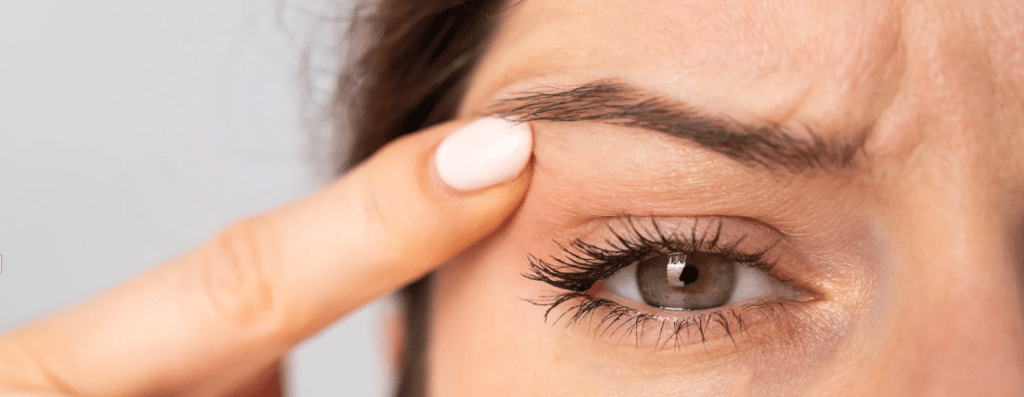
At-Home Tips and When to Seek Professional Help in North Texas
Droopy Eyelids: Causes, Remedies, and When to Seek Help in North Texas
Droopy eyelids can leave you looking tired, reduce your field of vision, and impact your self-confidence. While many people associate droopy eyelids with a condition called ptosis, other factors such as aging, excess skin, or underlying medical issues can also contribute to sagging lids.
If your eyelids are mildly droopy, there are effective at-home remedies to try. However, for more significant concerns, professional care might be necessary. Let’s explore both self-help tips and signs that it may be time to consult an expert. Dr. Mark Jaffe is our onsite oculoplastic surgeon and offers a variety of procedures aimed to give you back your youthful appearance.
What Causes Droopy Eyelids?
To understand how to address droopy eyelids, it’s important to identify the underlying cause. Here’s a breakdown of the most common reasons:
| Cause | Description | Potential Indicators |
|---|---|---|
| Ptosis Watch Video on Ptosis | Weakness or dysfunction of the levator muscle, often due to nerve issues. | One or both eyelids droop; may worsen throughout the day. |
| Dermatochalasis | Excess skin on the upper eyelid caused by aging or genetics. | Heavy, sagging lids; puffiness around the eyes. |
| Allergies or Inflammation | Swelling from allergic reactions or chronic irritation. | Redness, itching, and swelling around the eyes. |
| Fatigue or Lifestyle | Lack of sleep or dehydration can make lids appear droopy. | Temporary puffiness and tired-looking eyes. |
| Trauma or Injury | Damage to the eyelid or surrounding structures. | Visible scarring, drooping, or difficulty moving the eyelid. |
| Neurological Conditions | Disorders like myasthenia gravis or Horner’s syndrome affecting muscle control. | Sudden drooping, uneven pupils, or additional neurological symptoms. |
| Medical Conditions | Conditions like diabetes or thyroid disease can affect eyelid appearance. | Associated systemic symptoms like weight changes, fatigue, or changes in vision. |
At-Home Tips for Droopy Eyelids
If your droopy eyelids are mild or caused by temporary factors, these self-care strategies can help:
Strengthen Your Eyelids with Simple Exercises
Did you know that eyelid exercises can help tone the muscles around your eyes? While they won’t fix severe drooping or excess skin, these easy exercises can improve muscle strength and reduce eye fatigue in mild cases. Think of them as a mini workout for your eyes! Here’s how to get started:
Eyelid Lifts:
- Focus on a stationary object.
- Gently raise your eyelids as high as possible, hold for 3 seconds, and relax.
- Repeat 10–15 times daily.
Resistance Blinking:
- Lightly place your fingertips on your eyelids to create gentle resistance.
- Blink slowly while maintaining the resistance.
- Perform 10 repetitions.
Boost Skin Elasticity Around Your Eyes
Want to improve the skin around your eyes? Science-backed ingredients like retinol and hyaluronic acid can help boost collagen and retain moisture, making your eyelids appear firmer and smoother over time.
- Retinol: A Vitamin A derivative that stimulates collagen and reduces fine lines.
- Hyaluronic Acid: Known for its intense hydration, it plumps and smooths skin.
- Natural Oils: Argan and rosehip oils provide antioxidant protection and hydration for improved elasticity.
Combine these ingredients in your skincare routine for gradual, visible results. For more significant concerns, professional treatments can provide additional support.
Cool and Refresh Tired Eyes
Feeling puffy or tired? Cooling treatments are a fast and effective way to reduce swelling and brighten the area around your eyes.
Try these quick remedies:
- Chilled cucumber slices
- Green tea bags (with caffeine)
- Gel cooling masks
Apply for 10–15 minutes to tighten blood vessels, reduce inflammation, and rejuvenate your eyes. You’ll feel the difference!
Adopt Healthy Habits for Youthful Eyes
Small changes to your daily routine can keep your eyes looking refreshed and firm:
- Stay Hydrated: Drink at least 8 glasses of water daily to reduce puffiness and keep your skin glowing.
- Sleep Well: Aim for 7–9 hours of quality sleep each night to reduce fatigue-related drooping.
- Eat Antioxidants: Add berries, spinach, and nuts to your diet to protect your skin and promote collagen production.
These habits support long-term eye health and skin vitality.
When to Seek Professional Help
At-home remedies can be helpful, but they may not address more significant concerns. Consider consulting a specialist if:
Drooping affects your vision or daily activities.
- Excess skin (dermatochalasis) impacts your comfort.
- You experience dryness, irritation, or discomfort.
- At-home treatments haven’t provided noticeable results.
Take the Next Step
If droopy eyelids are holding you back, professional care might be the solution. Dr. Jaffe specializes in treatments tailored to your needs, helping you look younger and feel more confident.
Schedule a consultation today to explore your options and take the first step toward brighter, more youthful eyes!





